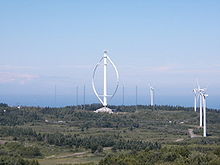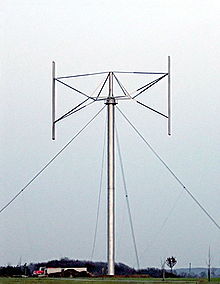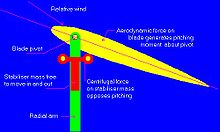- Darrieus wind turbine
-
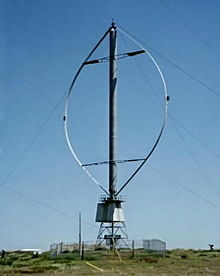 Fig. 1: A Darrieus wind turbine once used to generate electricity on the Magdalen Islands
Fig. 1: A Darrieus wind turbine once used to generate electricity on the Magdalen Islands
The Darrieus wind turbine is a type of vertical axis wind turbine (VAWT) used to generate electricity from the energy carried in the wind. The turbine consists of a number of aerofoils usually—but not always—vertically mounted on a rotating shaft or framework. This design of wind turbine was patented by Georges Jean Marie Darrieus, a French aeronautical engineer in 1931.
The Darrieus type is theoretically just as efficient as the propeller type if wind speed is constant, but in practice this efficiency is rarely realised due to the physical stresses and limitations imposed by a practical design and wind speed variation. There are also major difficulties in protecting the Darrieus turbine from extreme wind conditions and in making it self-starting.
Contents
Method of Operation
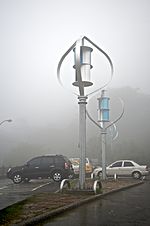 Combined Darrieus-Savonius generator in Taiwan
Combined Darrieus-Savonius generator in Taiwan
In the original versions of the Darrieus design, the aerofoils are arranged so that they are symmetrical and have zero rigging angle, that is, the angle that the aerofoils are set relative to the structure on which they are mounted. This arrangement is equally effective no matter which direction the wind is blowing—in contrast to the conventional type, which must be rotated to face into the wind.
When the Darrieus rotor is spinning, the aerofoils are moving forward through the air in a circular path. Relative to the blade, this oncoming airflow is added vectorially to the wind, so that the resultant airflow creates a varying small positive angle of attack (AoA) to the blade. This generates a net force pointing obliquely forwards along a certain 'line-of-action'. This force can be projected inwards past the turbine axis at a certain distance, giving a positive torque to the shaft, thus helping it to rotate in the direction it is already travelling in. The aerodynamic principles which rotate the rotor are equivalent to that in autogiros, and normal helicopters in autorotation.
As the aerofoil moves around the back of the apparatus, the angle of attack changes to the opposite sign, but the generated force is still obliquely in the direction of rotation, because the wings are symmetrical and the rigging angle is zero. The rotor spins at a rate unrelated to the windspeed, and usually many times faster. The energy arising from the torque and speed may be extracted and converted into useful power by using an electrical generator.
The aeronautical terms lift and drag are, strictly speaking, forces across and along the approaching net relative airflow respectively, so they are not useful here. We really want to know the tangential force pulling the blade around, and the radial force acting against the bearings.
When the rotor is stationary, no net rotational force arises, even if the wind speed rises quite high—the rotor must already be spinning to generate torque. Thus the design is not normally self-starting. Under rare conditions, Darrieus rotors can self-start, so some form of brake is required to hold it when stopped.
One problem with the design is that the angle of attack changes as the turbine spins, so each blade generates its maximum torque at two points on its cycle (front and back of the turbine). This leads to a sinusoidal (pulsing) power cycle that complicates design. In particular, almost all Darrieus turbines have resonant modes where, at a particular rotational speed, the pulsing is at a natural frequency of the blades that can cause them to (eventually) break. For this reason, most Darrieus turbines have mechanical brakes or other speed control devices to keep the turbine from spinning at these speeds for any lengthy period of time.
Another problem arises because the majority of the mass of the rotating mechanism is at the periphery rather than at the hub, as it is with a propeller. This leads to very high centrifugal stresses on the mechanism, which must be stronger and heavier than otherwise to withstand them. One common approach to minimise this is to curve the wings into an "egg-beater" shape (this is called a "troposkein" shape, derived from the Greek for "the shape of a spun rope") such that they are self supporting and do not require such heavy supports and mountings. See. Fig. 1.
In this configuration, the Darrieus design is theoretically less expensive than a conventional type, as most of the stress is in the blades which torque against the generator located at the bottom of the turbine. The only forces that need to be balanced out vertically are the compression load due to the blades flexing outward (thus attempting to "squeeze" the tower), and the wind force trying to blow the whole turbine over, half of which is transmitted to the bottom and the other half of which can easily be offset with guy wires.
By contrast, a conventional design has all of the force of the wind attempting to push the tower over at the top, where the main bearing is located. Additionally, one cannot easily use guy wires to offset this load, because the propeller spins both above and below the top of the tower. Thus the conventional design requires a strong tower that grows dramatically with the size of the propeller. Modern designs can compensate most tower loads of that variable speed and variable pitch.
In overall comparison, while there are some advantages in Darrieus design there are many more disadvantages, especially with bigger machines in the MW class. The Darrieus design uses much more expensive material in blades while most of the blade is too close to the ground to give any real power. Traditional designs assume that wing tip is at least 40m from ground at lowest point to maximize energy production and lifetime. So far there is no known material (not even carbon fiber) which can meet cyclic load requirements.[citation needed]

Giromills
Darrieus's 1927 patent also covered practically any possible arrangement using vertical airfoils. One of the more common types is the Giromill or H-bar design, in which the long "egg beater" blades of the common Darrieus design are replaced with straight vertical blade sections attached to the central tower with horizontal supports.
Cycloturbines
Another variation of the Giromill is the Cycloturbine, in which each blade is mounted so that it can rotate around its own vertical axis. This allows the blades to be "pitched" so that they always have some angle of attack relative to the wind. The main advantage to this design is that the torque generated remains almost constant over a fairly wide angle, so a Cycloturbine with three or four blades has a fairly constant torque. Over this range of angles, the torque itself is near the maximum possible, meaning that the system also generates more power. The Cycloturbine also has the advantage of being able to self start, by pitching the "downwind moving" blade flat to the wind to generate drag and start the turbine spinning at a low speed. On the downside, the blade pitching mechanism is complex and generally heavy, and some sort of wind-direction sensor needs to be added in order to pitch the blades properly.
A schematic of a self-acting pitch control system that does not require a wind-direction system is shown in Figure 4.
Helical blades
The blades of a Darrieus turbine can be canted into a helix, e.g. three blades and a helical twist of 60 degrees, similar to Gorlov's water turbines. Since the wind pulls each blade around on both the windward and leeward sides of the turbine, this feature spreads the torque evenly over the entire revolution, thus preventing destructive pulsations. This design is used by the Turby, Urban Green Energy and Quiet Revolution brands of wind turbine.
External links
- Bibliography of VAWT-related papers
- Three Pitch Control Systems for Vertical Axis Wind Turbines Compared - L. Lazauskas
- Experimental Verification of a Mathematical Model for Predicting the Performance of a Self-acting Variable Pitch Vertical Axis Wind Turbines - B.K. Kirke and L. Lazauskas
- Video of a large Darrieus in Colorado flying
- US patent 1,835,018
- Cranfield University press release on novel-configuration vertical-axis wind turbine for offshore generation
Wind power Wind power 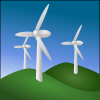
Wind power by country Wind turbines - Aerodynamics
- Airborne
- Darrieus
- Design
- Floating
- Savonius
- Quietrevolution
- Small
- Unconventional
- Vertical axis
- Devices in use
Wind power industry - Consultants
- Manufacturers
- Software
- Wind farm management
Wind farms - Community-owned
- List of offshore wind farms
- List of onshore wind farms
Concepts - Betz' law
- Capacity factor
- EROEI
- Grid energy storage
- HVDC
- Intermittency
- Net energy gain
- Storage
- Subsidies
- Wind power forecasting
- Wind profile power law
- Wind resource assessment
Categories:- Vertical axis wind turbines
Wikimedia Foundation. 2010.

